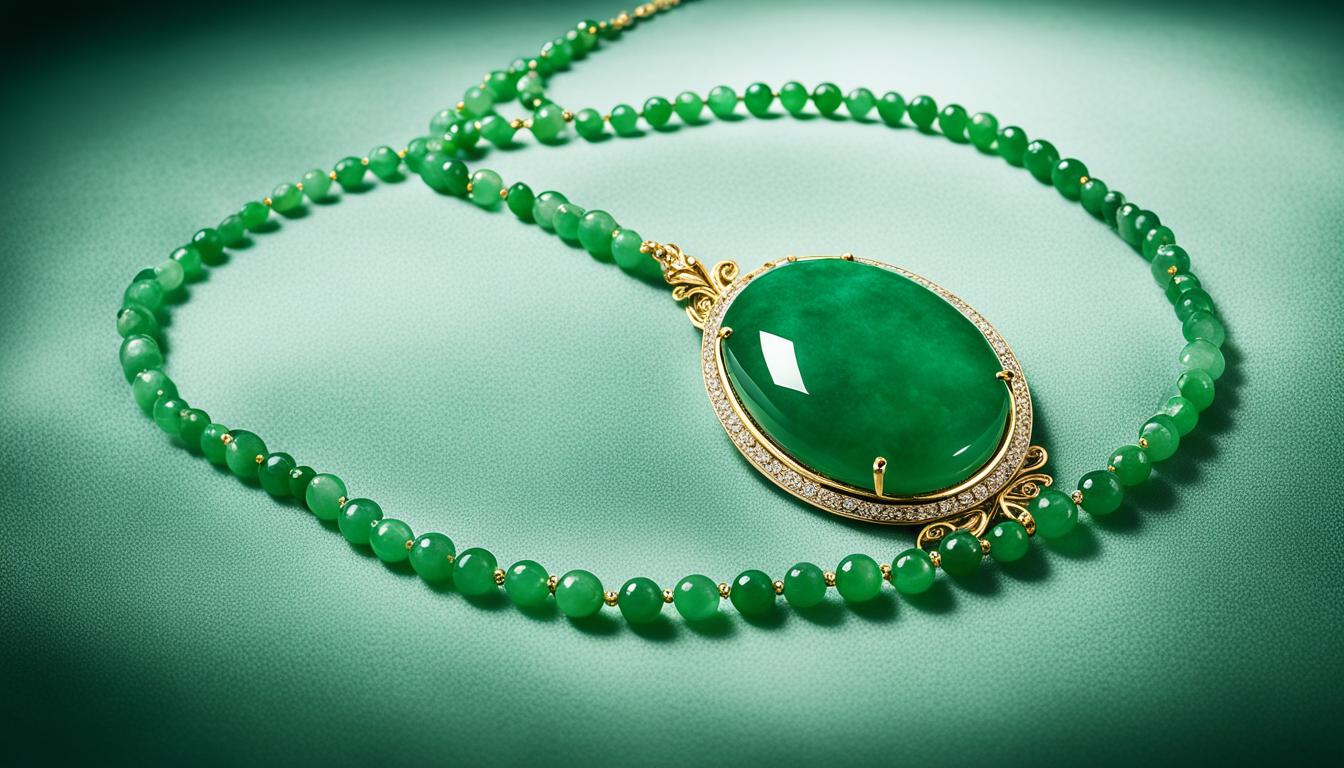Did you know jade necklaces are more than pretty? They also make great decor. Many people love them for cleaning the air, being safe for pets, and fitting in small places. In this guide, you will learn everything about jade necklaces for your home. It’s perfect if you want to decorate or learn to take care of one.
Key Takeaways:
- Discover why jade necklaces are becoming increasingly popular for apartment decor.
- Learn about the air-purifying and pet-friendly properties of jade necklaces.
- Find out how to grow, maintain, and style a jade necklace in your apartment.
- Explore the different varieties and appearances of jade necklaces.
- Get tips on providing the right light, water, and fertilizer for your jade necklace.
Why Do We Love the Jade Necklace For Apartments?
Let’s find out why people in apartments love the jade necklace so much. It’s stylish and easy to care for. Plus, it cleans the air. A great pick for your home!
Is the Jade Necklace Air-Purifying?
The jade necklace is pretty and cleans the air. It removes toxins, which makes the air healthier. With this plant, your home looks good and the air is fresh.
Is the Jade Necklace Pet Friendly?
This plant is safe for pets. It’s not harmful to cats or dogs. So, you can have a beautiful jade necklace and happy pets too.
How Big Does the Jade Necklace Get?
The jade necklace stays small. Perfect for apartments without much room. It fits nicely on tables, shelves, or windowsills. It makes any space elegant.
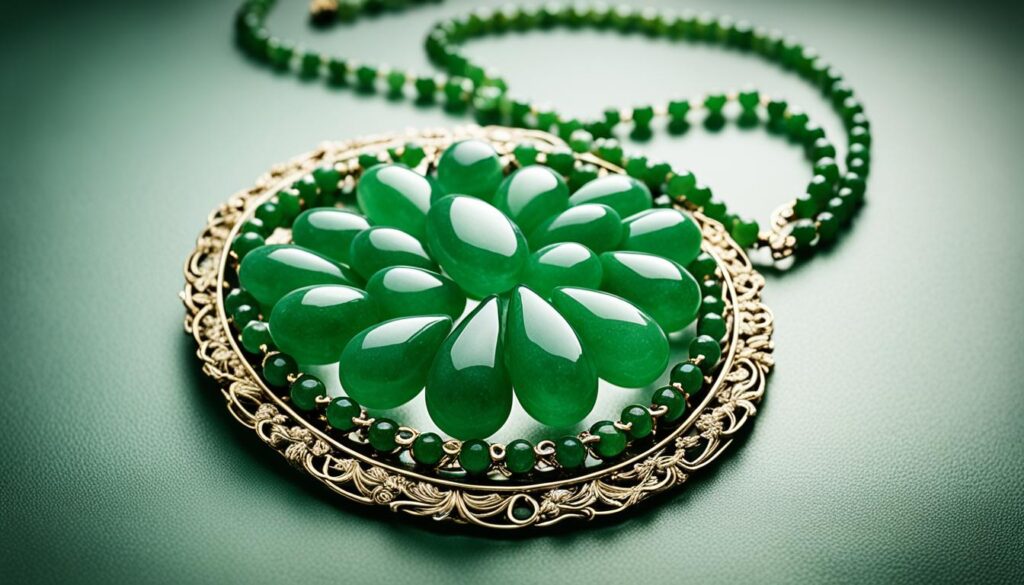
The jade necklace is great for apartment life. It cleans the air, is safe for pets, and doesn’t need much space. It’s perfect for anyone who loves plants and wants to make their home lovely.
| Benefits of the Jade Necklace for Apartments |
|---|
| Air-purifying properties |
| Pet-friendly |
| Compact size |
How to Grow a Jade Necklace – Learn to Grow this Indoor Beauty
I’ll show you how to grow a jade necklace inside. We will start by choosing the right pot and soil. Then, we will talk about getting the light just right and how much to water it. I will share tips on how to feed your plant and keep it healthy. We will also look at how to make more plants from the one you have. Lastly, we will learn how to watch for bugs and diseases.
Choosing the Right Pot and Soil
Pick a pot with holes at the bottom for your jade necklace. This stops the soil from getting too wet. A pot that is shallow and wide is best. It is like the plant’s home in nature. For soil, get a mix that drains well and is for cacti and succulents. This soil stops too much water from staying and gives nutrients for your plant to grow strong.
Providing Adequate Light
Jade necklaces need a lot of light, but not direct sun. Put your plant near a window where the light is soft. Or use a special plant light if you don’t have enough natural light. Turn your plant so it gets light from all sides. This helps it grow evenly.
Watering and Humidity
Don’t water your jade necklace too much. It likes to be dry. Let the soil dry out before you water it again. Water less often in winter. Jade necklaces don’t need much humidity. This makes them perfect for growing inside.
Nutrition and Fertilization
Your jade necklace doesn’t need a lot of food. Feed it a little during its growing time. Use a special food for succulents. Put only half of what the instructions say. Too much food is not good for your plant.
Pruning and Maintenance
Cut back your jade necklace to keep it looking nice. Trim the long stems and take off any bad leaves. Always check for bugs or sick parts. Fix these problems right away to keep your plant happy.
Propagation
It’s easy to get more jade necklaces. You can use stem cuttings or leaves. For stem cuttings, cut a stem and let it dry a bit. Then, plant it in good soil. For leaves, pick a healthy one and let it root before planting. Both ways work well.
Monitoring for Pests and Diseases
Even tough plants like jade necklaces can get sick. Look for bugs like mealybugs or spider mites. If you find them, treat your plant right away. Also, watch out for wet roots or fungus. Keep your plant dry and airy to avoid these problems.
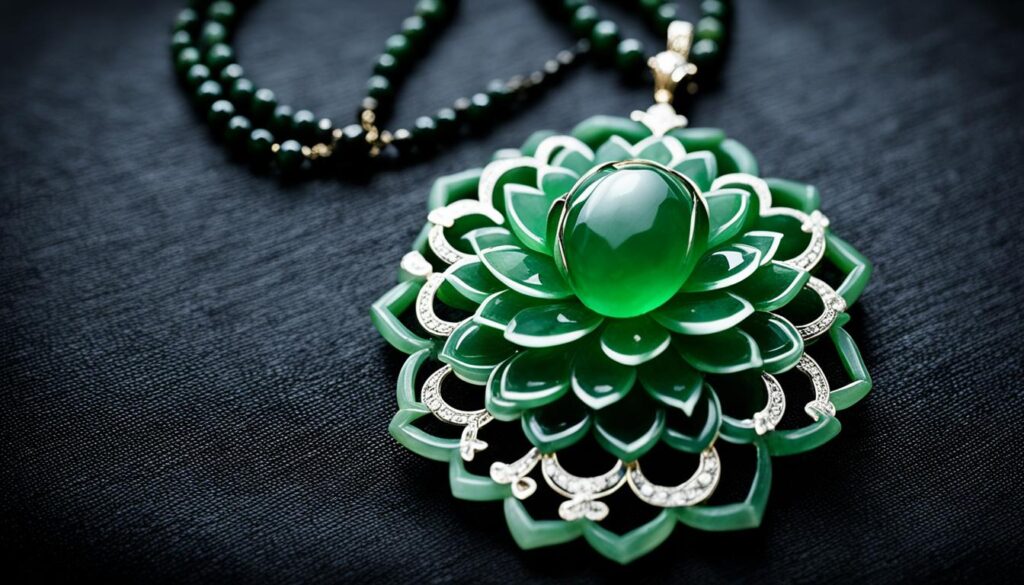
Comparison of Indoor Conditions for Growing a Jade Necklace
| Factors | Ideal Conditions | Suboptimal Conditions |
|---|---|---|
| Light | Bright, indirect light | Low light, direct sunlight |
| Watering | Infrequent, allowing soil to dry out between waterings | Overwatering, waterlogged soil |
| Humidity | Low humidity | High humidity |
| Soil | Well-draining mix for cacti and succulents | Compacted soil, poor drainage |
| Temperature | 60-75°F (15-24°C) | Extreme temperature fluctuations |
Next, we’ll look at what a jade necklace looks like. We will talk about the colors and shapes of its leaves.
Appearance of Jade Necklace
Let’s talk about how a jade necklace looks. Its leaves are thick and hold water. This helps the plant live in dry places. The leaves are a bright green color. This makes any room look nicer.
Jade necklaces have leaves in different greens. From dark emerald to light green. Some have green and white or yellow patterns. Each jade necklace is special because of these colors.
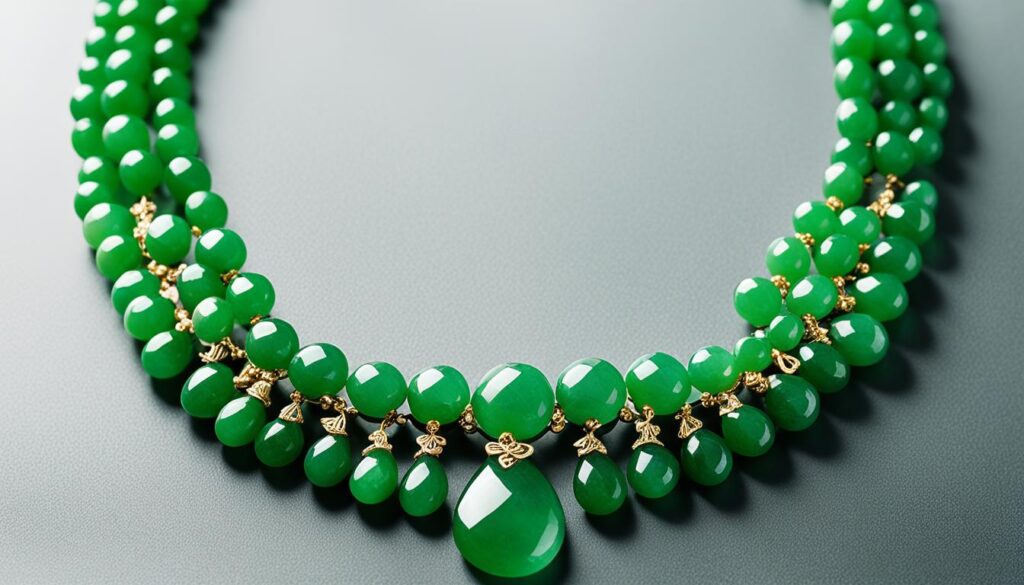
Light Requirements for Jade Necklace
Light is very important for a jade necklace to grow. It does best in bright, but not direct, sunlight. Here, you’ll learn how to pick the best spot at home for it.
To show why light matters for the jade necklace, think about this:
How well the jade necklace makes food and energy depends on the light it gets. Not enough light makes it weak, causes leaves to fall, and makes it less green. Too much sun can hurt its leaves.
It’s important to find a good middle ground. Your jade necklace needs light, but not too strong. You can put it near a window with a sheer curtain. This protects it from too much sun while helping it grow well.
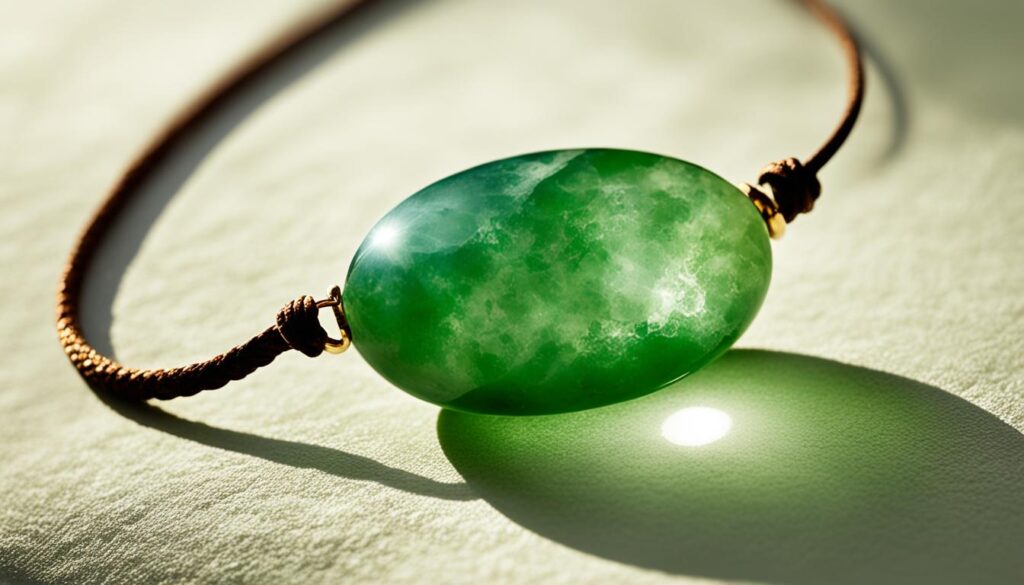
| Lighting Conditions | Suitable For Jade Necklace? |
|---|---|
| Bright, indirect light | Yes |
| Low light | No |
| Direct, intense sunlight | No |
Note: Turn your jade necklace often. This makes sure it grows evenly and doesn’t lean too much towards the light.
Right light helps your jade necklace grow well. It makes sure your plant stays healthy and looks great.
Watering Requirements of the Jade Necklace
Knowing how to water your jade necklace is key. It helps keep your plant healthy and pretty. This part will guide you on the right way to do it. It ensures your plant gets just enough water.
Signs of Overwatering vs. Underwatering
It’s important to know the signs of too much or too little water. Knowing these signs lets you take care of your plant better.
Signs of Overwatering:
- Yellowing or browning leaves
- Soft, mushy stems
- Mold or mildew on the soil surface
- Foul odor coming from the soil
- Root rot
Signs of Underwatering:
- Wilting or drooping leaves
- Dry soil that pulls away from the pot edges
- Yellow or crispy leaves
- Pale or dull-looking foliage
- Stunted growth
Now you know what to look for. Let’s learn how to water your jade necklace correctly.
When watering your jade necklace, just follow these tips:
- How often: Water when the top soil is dry. Usually, this means once every two weeks. Still, weather can change things. Watch your plant and water as needed.
- How much: Water it well until it drains out the bottom. Don’t let it sit in water. Throw away any extra water in the tray.
- Seasonal tips: Your plant’s water needs change with the seasons. Water more in spring and summer. Water less in fall and winter. Adjust how you water based on the season.
Keeping the water just right is very important. Doing this helps stop root rot. It keeps your plant looking beautiful.
Fertilizing a Jade Necklace
Fertilizing is key for a healthy jade necklace. It ensures the plant grows well and looks great. Here, I’ll share the top fertilizers for jade necklaces and tips on fertilizing.
Recommended Fertilizer for a Jade Necklace
There are many fertilizers to pick from for your jade necklace. Organic ones are loved for being natural and soft on plants. They give slow nutrients, leading to steady growth and no over-fertilizing. Fish emulsion or compost are great since they have plenty of nitrogen, phosphorus, and potassium.
Synthetic fertilizers work fast because of their special nutrient mix. They quickly fix nutrient shortages. A balanced fertilizer should have an NPK ratio like 10-10-10 or 20-20-20. This mix feeds your jade necklace well.
Always check the fertilizer’s label before using it. Too much fertilizer can harm your plant. During spring and summer, fertilize every 2-4 weeks. In fall and winter, fertilize less.
To feed your jade necklace, mix the fertilizer with water at half strength. Use it to water the plant so the soil gets fully wet. This gently gives nutrients to the roots. Don’t let the fertilizer touch the leaves. It could burn them.
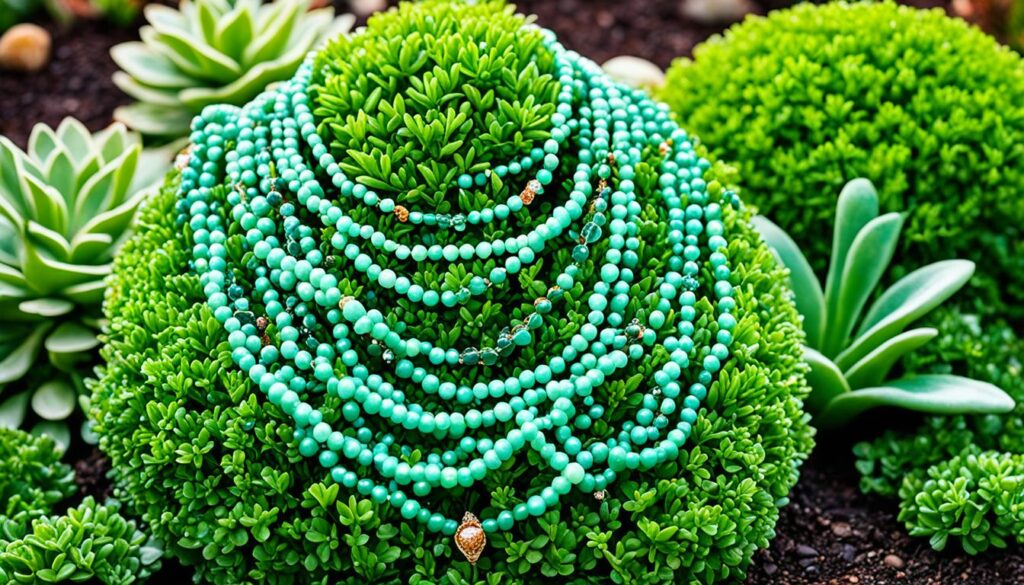
Right nutrient balance is essential for your jade necklace. Watch how your plant reacts to fertilizer. Change how often and how much you use based on what you see. A regular fertilizing plan will keep your jade necklace beautiful and healthy.
| Fertilizer Type | Advantages | Disadvantages |
|---|---|---|
| Organic | – Slow-release of nutrients – Gentle on the plant – Promotes consistent growth |
– Nutrient content may vary – Requires larger quantities |
| Synthetic | – Quick absorption – Specific nutrient ratios – Fast-acting |
– Risk of over-fertilization – Chemical-intensive |
Potting a Jade Necklace
Potting your jade necklace is key. It helps your plant grow strong and healthy. In this guide, I’ll show you how to pot your jade necklace right. You’ll learn to give your plant a great start.
Choosing the Right Pot Size
It’s important to pick the right pot for your jade necklace. A too small pot can harm root growth. A too big pot might cause too much wetness.
The perfect pot size depends on your plant’s size and stage. Aim for a pot 1-2 inches bigger in diameter than the current one. This allows the roots to grow well.
Using the Right Potting Mix for a Jade Necklace
The potting mix is vital for your jade necklace’s health. It needs to drain well but also keep roots moist.
A top mix has succulent or cactus potting mix with perlite or coarse sand. This helps avoid too much water in the pot.
Repotting When Necessary
Sometimes, your plant outgrows its pot. You might see roots crowding or the plant tipping over.
To repot, carefully take the plant out. Fix any tight roots and cut off bad ones. Put it in a new pot with fresh mix. Don’t pack the soil too tight to avoid root issues.
After repotting, wait a bit before watering. This helps the plant settle and prevents shock.
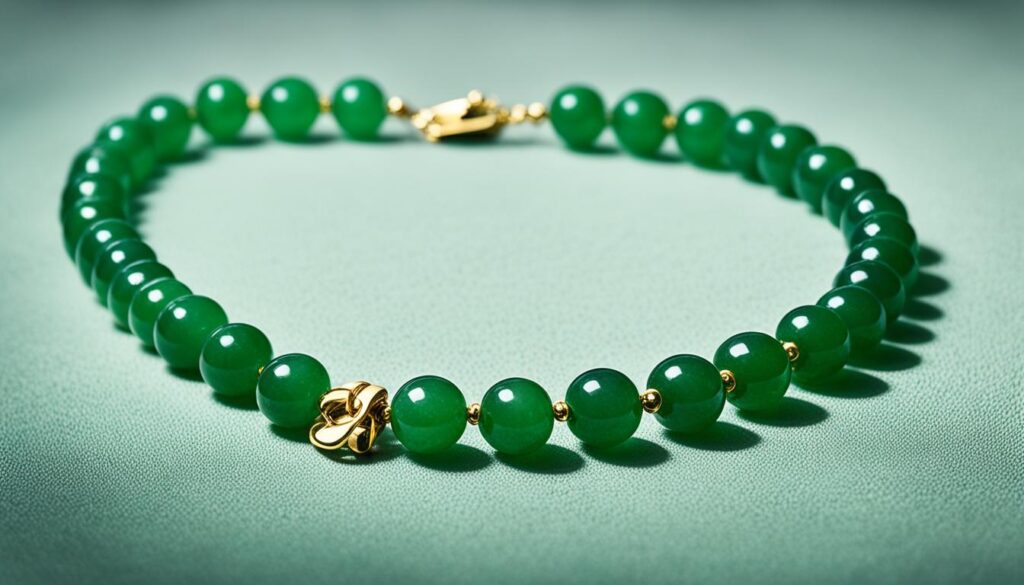
Propagating a Jade Necklace
Propagation lets you grow more jade necklaces or give them to friends and family. We’ll look at two ways to do this: stem cuttings and division. I’ll show you how to do each one and share tips to help you succeed.
Stem Cuttings Or Seeds?
Stem cuttings are a great way to make new jade necklaces. You take a piece of the stem and help it grow roots. This way, you get a plant just like the one you started with.
Growing from seeds is less common. It takes longer, and the new plant might look different. But it’s still a way to grow jade necklaces.
If you’re new to this, try stem cuttings. They grow faster and are more likely to work out.
Division Of A Jade Necklace
Division is another way to make more plants. You split one plant into parts that can grow on their own. It’s good for plants with lots of stems or clusters that you can easily separate.
For division, take the plant out of its pot and carefully split it. Make sure each part has roots and leaves. This helps it grow well on its own.
After splitting, put each part in new soil. Water them and keep them in light but not direct sun. This helps them grow roots and leaves.
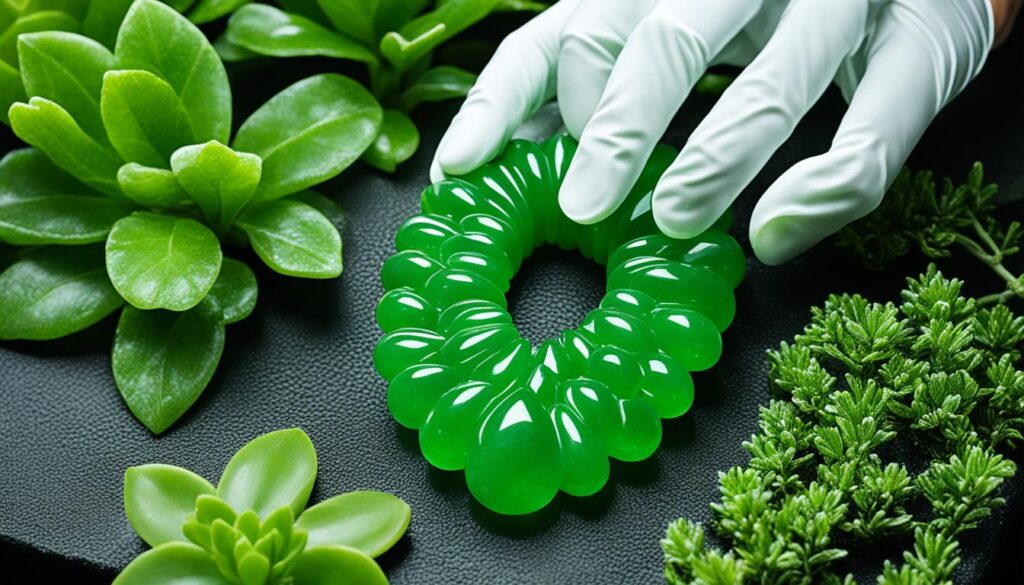
Propagating your jade necklace is fun. You can make your garden bigger or share plants with friends. With stem cuttings or division, you can grow healthy, beautiful plants.
Growth and Development of the Jade Necklace
Jade necklaces grow in a cool way that is fun to see.
As a plant lover, you’ll like watching your jade necklace grow. Knowing about its growth helps you take good care of it.
Jade necklaces start with a few leaves. Then, they get more as they get older.
The new leaves begin as small buds. They slowly open up. This shows their pretty green color and unique shape.
The branches of a jade necklace get stronger as it grows.
At first, they are thin and weak. But they get thicker and stronger with time. This makes the plant stronger and better at holding its leaves.
Jade necklaces are usually small but can get big with good care.
A big jade necklace looks great in any room. But how big it gets depends on the space, light, and health of the plant.
To see how a jade necklace grows, check out this picture below:
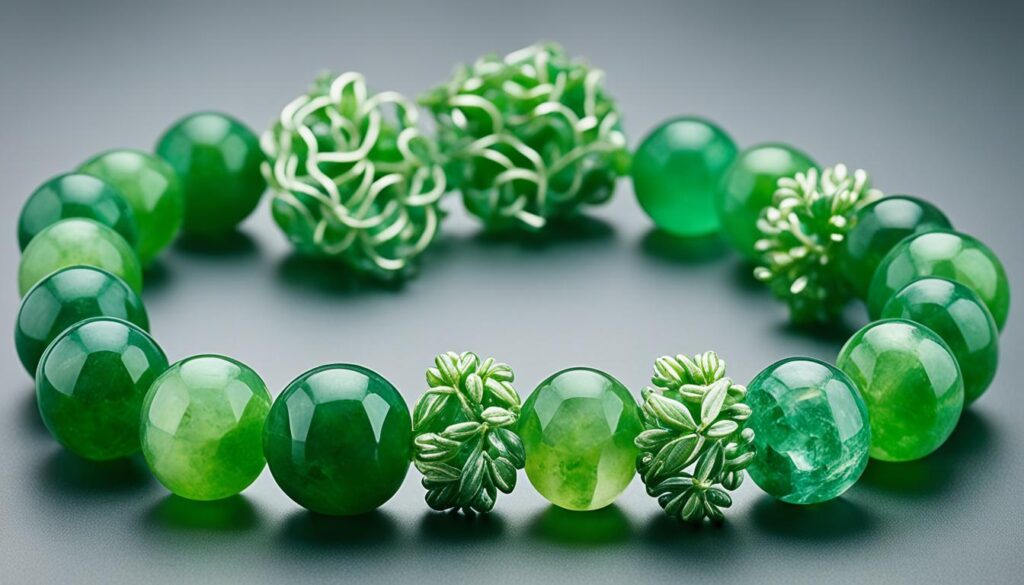
Dealing with Pests and Diseases in the Jade Necklace
Jade necklaces, like all plants, can face pests and diseases. It’s key to watch your plant and act fast if there’s trouble. Here, I’ll talk about common problems and how to deal with them.
Preventing Pests:
Pests stay away from places they don’t like. Here’s how to keep them away:
- Look at your plant often for pests like webs, spots, or leaf damage.
- Keep where your plant is clean. This helps keep pests away.
- Make sure air can flow around your plant. Don’t let too many plants crowd it.
- Keep new plants away from your jade necklace for a while. This helps stop pests.
Natural Remedies:
Seeing pests? Try these natural ways to get rid of them:
- Put on neem oil or insecticidal soap. Use it as the label says.
- Wash the leaves with water and a little dish soap. Rinse well after.
- Add good bugs like ladybugs. They eat the bad pests.
Chemical Treatments:
Sometimes, you might need chemicals to fight pests. Be sure to use them right. Choose ones made for indoor plants. Don’t overuse them.
Stopping pests before they start is the best way. Care for your jade necklace well. Keep its home clean. Act fast if you see pests. This helps keep your plant happy and free from pests.
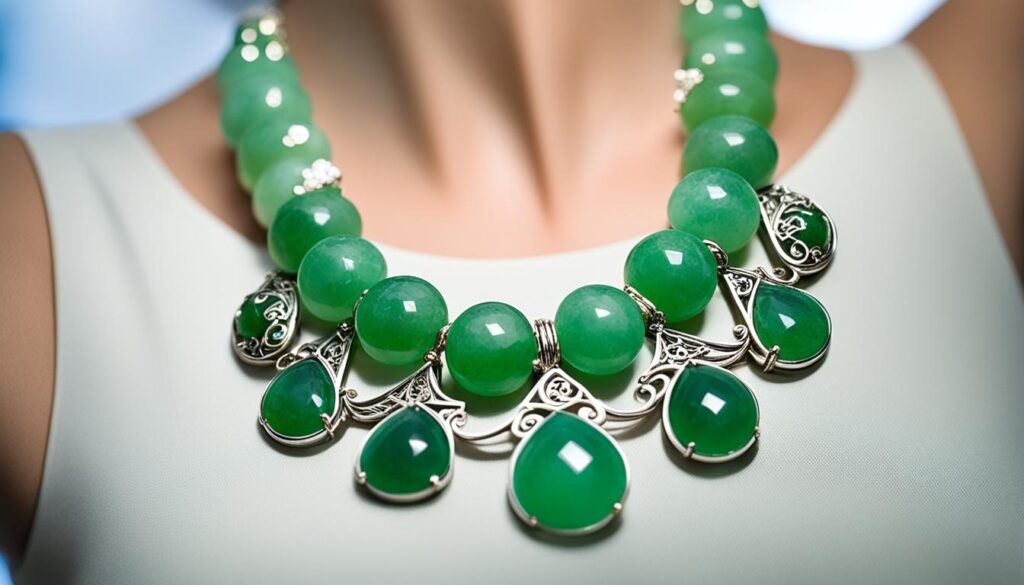
Common Jade Necklace Pests
Jade necklaces are mostly easy indoor plants. But they can still get a few pests. It’s important to know these pests. This way, you can keep your jade necklace healthy.
Here are some pests that might bother your jade necklace:
- Mealybugs: These bugs look white and powdery. They live on the leaves and stems. They drink sap from the jade necklace. This makes the plant grow poorly and leaves turn yellow.
- Spider Mites: Spider mites are tiny spiders. They make fine webs on the leaves. They eat plant sap. This makes the leaves change color, get spots, and fall off.
- Aphids: Aphids are small and can be green, black, or brown. They gather on new growth. They suck sap and make the leaves grow weird.
Check your jade necklace’s leaves and stems often. Look for sticky stuff, webs, or bugs. If you see any pests, act fast. This stops more harm to your plant.
Natural Predators
Natural predators can help you deal with pests in your jade necklace. They eat the pests and keep your plants healthy without chemicals.
To attract these helpers to your indoor garden, make a welcoming space. Here’s how:
- Plant different flowers and herbs. They draw in helpful bugs that eat pests.
- Put shallow dishes with pebbles and water for thirsty predatory insects.
- Grow plants together that push pests away. This also brings good bugs.
- Less pesticides mean more natural helpers. Try organic ways to fight pests.
Isolate Infected Plants
Separating sick plants is key to stopping pests. If your jade necklace looks ill, move it right away.
Keep the sick plant in a different room. This way, pests won’t jump to healthy ones. You can then treat the plant easier.
Chemical Treatment
Sometimes, you might need chemicals to save your jade necklace. Use them if you’ve tried everything else or if the pests are too many.
Always read the instructions and wear safety gear. Try to use safe or organic options. This protects good bugs and our earth.
Chemicals are a last choice. Always try to help your plants in natural ways first.
Disease Prevention For Jade Necklaces
Keeping your jade necklace free from diseases is crucial. Follow these tips to keep it healthy and looking great.
1. Proper sanitation: Cleanliness helps stop harmful fungi, bacteria, and pests. Wipe the leaves and stems with a soft, damp cloth to keep them clean.
2. Maintaining optimal growing conditions: Jade necklaces need well-draining soil and not too much humidity. Do not overwater. This can cause root rot. Keep the temperature steady and avoid big changes.
3. Avoiding common mistakes: Too much fertilizer, bad potting soil, and putting plants too close can invite diseases. Use the right amount of fertilizer. Make sure your potting soil is clean. Give your plants enough room for air to flow.
4. Monitoring for signs of disease: Check your jade necklace often for any bad signs. Look for discoloration, wilting, or spots. Catching diseases early can help stop them from spreading.
Prevention is the best approach. Use these tips to keep your jade necklace plants strong and healthy.
Tips for Maintaining Jade Necklaces
Keeping your jade necklace in top shape is key. I’ll share easy tips with you. These include cleaning the leaves, changing how much water you give it, and where to put it outside. Follow these steps to make your jade necklace shine all the time.
Wiping Leaves
Cleaning your jade necklace’s leaves is crucial. Dust stops the plant from making food from sunlight. Use a soft, wet cloth to clean every leaf. This keeps the dust off and lets the plant get light and grow well.
Outdoor Exposure
Jade necklaces like being indoors but also enjoy outside time when it’s warm. Be careful where you put them outside, though. Too much sun can hurt the leaves. Find a spot with shade for your jade necklace. This gives it air and light safely.
Adjusting Watering Schedule
Your jade necklace needs different amounts of water as seasons change. It needs more water in the warm, growing months. Let the soil dry out a bit between watering times. But don’t let it get too dry. In the cold, resting months, water it less. Make sure the soil is really dry before watering again. Changing when you water keeps your jade necklace healthy.
Tips for Successful Overwintering of Jade Necklace
If you live where winters are cold, overwintering your jade necklace is key. Here, I’ll share how to keep your jade necklace healthy in winter. You’ll learn about the right temperature, light, water, and food for your plant.
1. Temperature control: Keep your jade necklace in a warm place. Make sure it stays between 60-75°F (15-24°C).
2. Light exposure: They need bright light but not direct sun in winter. Put it near a south-facing window or use grow lights.
3. Adjust watering: They need less water in winter. Only water when the soil starts to dry. This helps avoid too much water and root problems.
4. Fertilization: In winter, your jade necklace grows slowly. Fertilize it less, only once every 2-3 months, with weak food.
5. Avoid cold drafts: Keep your plant away from cold air and sudden cold. Places near doors and windows might be too chilly.
6. Monitor humidity: The air is drier in winter. This can affect your plant. Use a humidifier or a water tray to add moisture.
Using these tips helps your jade necklace stay healthy and pretty in winter. It brings green beauty to your home.
Growing Jade Necklace from Seed
Propagating jade necklaces usually happens through cuttings or division. Yet, you can grow them from seed too. Growing from seed is fun and rewarding for plant lovers. I will show you how to do it from the beginning to having a full-grown plant.
To start, you need to collect seeds from a mature jade necklace plant. The seeds are inside the plant’s fruit. After collecting the seeds, you can begin the germination phase.
To germinate jade necklace seeds, follow these steps:
- Prepare a well-draining seed-starting mix in a small container or seed tray.
- Moisten the soil lightly to make it a bit damp.
- Place the jade necklace seeds on the soil, spaced out evenly.
- Press the seeds lightly into the soil to make sure they touch it well.
- Cover the seeds with a thin soil layer or use vermiculite.
- Put the container or tray in a warm spot with bright, indirect light.
- Keep the soil moist by misting or watering lightly.
- Wait for germination, which takes a few weeks to a few months. Be patient and watch the soil moisture.
After the seeds sprout and the seedlings have true leaves, move them to new pots. Use well-draining soil and begin exposing them to more light and drier conditions.
Caring for jade necklace seedlings is like caring for adult plants. They need bright, indirect light, moderate water, and well-draining soil. Watch their growth and adjust care as needed.
By growing a jade necklace from seed, you get to see the whole life cycle of this plant. It’s a great way to connect with your plant and grow your indoor garden.
Varieties of Jade Necklace
Jade necklaces are beautiful and unique. I’ll show you some popular types for indoor plants.
The green jade necklace is classic. It has thick green leaves. It fits any decor and is easy to care for. Perfect for all plant lovers.
Looking for something special? Try variegated varieties. They have leaves with cool patterns. Some have white or yellow edges. They are as easy to care for as green jade but look different.
There are many unique cultivars for collectors. They come in various sizes and leaf shapes. There’s something for everyone’s taste and space.
Every jade necklace type is special. They have different colors, shapes, and care needs. You can find the perfect one for your place and make it thrive.

